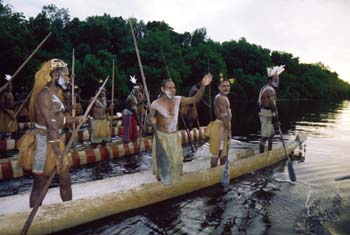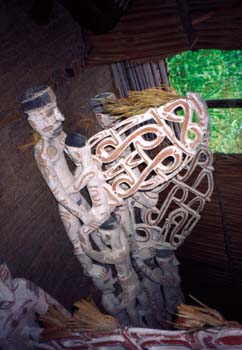
their New Guinea homeland on a field-collecting expedition
in 2001.
The mysterious tribal people known as the Asmat call themselves “the people of the tree.”
Their New Guinea homeland is dominated by a tropical rain forest, and both mangrove and sago trees figure prominently in their day-to-day living, in their art and in their unique spiritual traditions.
In fact, these former headhunters and cannibals believe that their first ancestors were created of wood.
In the summer of 2001, Jerry Martin, director of WSU’s Lowell D. Holmes Museum of Anthropology, traveled to New Guinea, to Indonesia’s province of Papua, formerly called Irian Jaya (see "Spirit People" in The Shocker, spring 2002).
This field-collecting expedition was made possible by the generous gift of Barry ’72 and Paula Downing, and organized and led by cultural expert Patti Seery. While in Asmat country, Martin amassed a collection of some 950 artifacts. Add to these the collection donated to the university by Peter Bakwin, and WSU now has one of the three most significant collections of Asmat artifacts in the country.
Each artifact collected by Martin and Seery is authentic, and they are not the pieces carved for tourist trade. Many of them are ceremonial; others are items used every day. Artifacts were gathered from various villages under strict supervision; meticulous records were kept of each item’s use, who made it, when it was used and its historical, cultural or spiritual significance. This provenance, or history, says Martin, makes WSU’s collection “the most important research collection in the United States.”
For the past three years, the collection has been stored in several rooms in Neff Hall, home of the anthropology department, while preparation and conservation work on the artifacts has taken place in the university’s geology lab. Carefully positioned, floor to ceiling, are intricately carved wooden ancestor figures, shields standing as tall as a man, drums worn smooth from years of use and mats and bags woven from sago leaves. Eerie-looking body masks stand in the center of the room.
Boasting one of the most artistic and creative cultures from old Melanesia, the Asmat see spiritual power and harmony as essential for a well-lived life. During many of their ceremonies, they invite the spirits of ancestors to return to the village, and many of the pieces in WSU’s collection were created to house these spirits.
Thus, woodcarving is inextricably linked to this world of ancestors. Many of the Asmat’s most dominant symbols express not only the link to ancestors but also the parallel of people and trees, especially the sago palm.

symbols express not only a link to
ancestors but also the parallel of
people and trees.
Many of the Asmat’s most dominant symbols express not only a link to ancestors but also the parallel of people and trees.
The fading away of intertribal warfare and headhunting has wrought major changes on the traditional patterns of Asmat life and art.
“When this violent way of life ended, something else had to take its place, and we don’t know what has. That’s what we’re trying to study,” Martin says.
Clues to the nature of this change are being found in the evolution of Asmat art forms. For instance, Martin explains, praying mantises were a common artistic theme on artifacts used during headhunting forays — female mantises are known to bite off the heads of males; thus, they represented the purpose of the hunt.
The mantis design is not found on artifacts made after the demise of headhunting.
After three years of preparation, the university’s Asmat collection is now ready for its public unveiling, which has been slated for April 23-24 with the opening of two different, but intimately related, exhibitions at the Holmes Museum of Anthropology and the Ulrich Museum of Art.
David Butler, director of the Ulrich Museum, describes the power of the collection by saying, “I’m not sure if they didn’t bring some stray spirits back with them.” He adds that the exhibition, Spirit Journeys: Art of the Asmat, is out of the ordinary for the Ulrich Museum, but that he and the entire museum staff are exceedingly pleased to be able to participate in this unique university event, especially since such exhibitions are so rare.
That’s partially because the Indonesian government strictly controls travel in Papua (which is located in the southern quadrant of the western half of New Guinea), making it ever more difficult for museums and universities to collect Asmat artifacts.
Butler notes that it was something of a miracle that allowed Martin to be so successful on his expedition, particularly in getting the whole collection shipped out of Indonesia and back to the United States.
The Holmes Museum will display Spirit Journeys: Ritual and Culture Among the Asmat. Both exhibitions open with a gala event at 6:30 p.m., April 23, beginning at the Holmes Museum. A trolley will be available to transport guests from one museum to the other.
There will also be food, entertainment and even the re-creation of a spirit mask ceremony held in a traditional yeu, or ceremonial house. The cost for this Friday evening’s event is $50 per person.
Festivities continue Saturday with a free family day celebration featuring access to both exhibits, videos, entertainment and special presentations by such Asmat experts as expedition leader Seery; Karl Heider, who has done major anthropological research in Irian Jaya; and John Burke Burnett, who is working with the Asmat to develop a local economy to prevent the destruction of their unique — and fascinating — culture.





